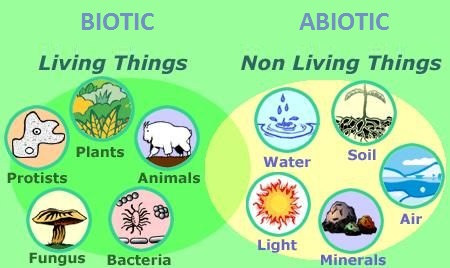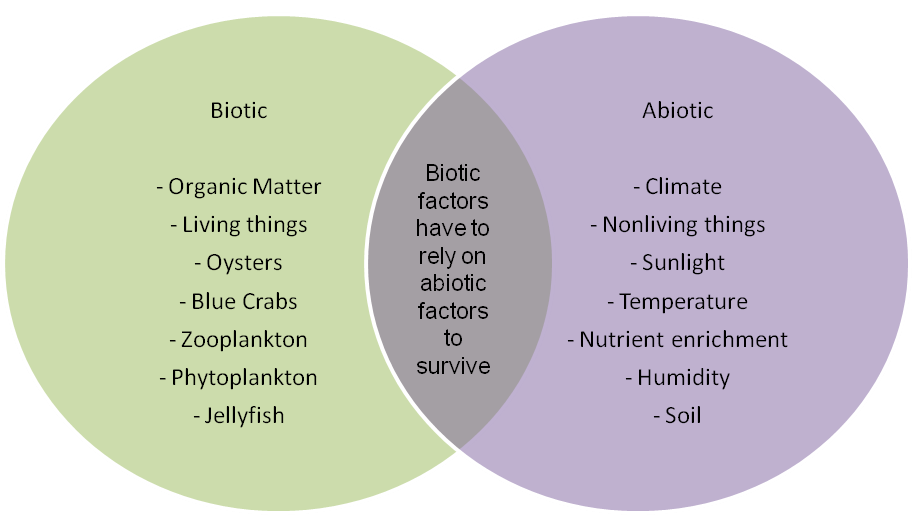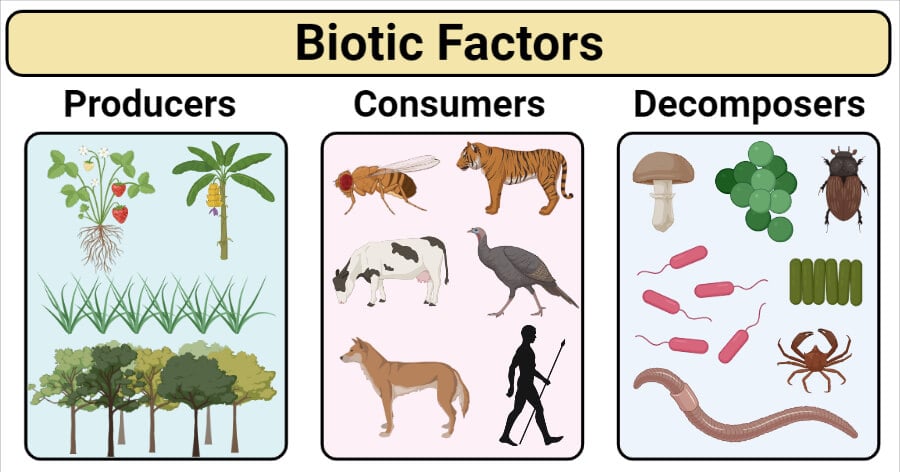Topic what are biotic and abiotic factors in an ecosystem: Explore the fascinating world of ecosystems, where biotic and abiotic factors intertwine to create the complex web of life, ensuring nature"s balance and diversity.
Table of Content
- What are biotic and abiotic factors in an ecosystem?
- Overview of Ecosystems
- Definition of Biotic Factors
- Examples of Biotic Factors
- Role of Biotic Factors in Ecosystems
- Definition of Abiotic Factors
- Examples of Abiotic Factors
- YOUTUBE: Biotic and Abiotic Factors in an Ecosystem
- Impact of Abiotic Factors on Ecosystems
- Interaction Between Biotic and Abiotic Factors
- Importance of Balancing Biotic and Abiotic Factors
- Human Impact on Biotic and Abiotic Factors
- Conservation Efforts for Ecosystem Balance
What are biotic and abiotic factors in an ecosystem?
Biotic and abiotic factors are two types of factors that influence an ecosystem. They play a crucial role in determining the health and balance of an ecosystem. Here\'s a breakdown of each type:
Biotic factors:
- Living organisms, including plants, animals, and microorganisms, constitute biotic factors in an ecosystem.
- These organisms interact with each other and with the abiotic factors in the ecosystem.
- Examples of biotic factors include trees, flowers, insects, birds, fish, mammals, and bacteria.
- Biotic factors can be categorized into producers (plants), consumers (animals), and decomposers (bacteria and fungi).
- Producers capture energy from the sun through photosynthesis, which is then passed on to consumers.
- Consumers obtain energy by consuming producers or other consumers.
- Decomposers break down dead organisms and organic matter, recycling nutrients back into the ecosystem.
Abiotic factors:
- Abiotic factors are non-living components of an ecosystem that still have a significant impact on living organisms.
- They include physical and chemical factors that affect the ecological processes within an ecosystem.
- Examples of abiotic factors include temperature, sunlight, water availability, soil composition, humidity, wind, and nutrients.
- Abiotic factors determine the type of organisms that can survive and thrive in a particular ecosystem.
- Organisms have adaptations that enable them to withstand and utilize specific abiotic factors.
- Changes in abiotic factors can affect the distribution and abundance of biotic factors in an ecosystem.
Both biotic and abiotic factors are interconnected and influence each other to maintain the balance and functioning of an ecosystem. Understanding these factors helps us comprehend the intricate web of life in our natural surroundings.
READ MORE:
Overview of Ecosystems
An ecosystem is a dynamic complex of plant, animal, and micro-organism communities and their non-living environment, interacting as a functional unit. This intricate network encompasses all living things, from microscopic bacteria to large mammals, and the physical environment they inhabit, including water, air, soil, and sunlight. Ecosystems can vary in size from a small puddle to an entire forest or ocean and are categorized into two main types: terrestrial and aquatic. Terrestrial ecosystems include forests, grasslands, and deserts, while aquatic ecosystems are split into freshwater (lakes, rivers) and marine (oceans, coral reefs) environments.
- Components of Ecosystems: Ecosystems consist of biotic (living) and abiotic (non-living) components. Biotic components include plants, animals, and microorganisms, while abiotic components encompass sunlight, water, air, and minerals.
- Functioning of Ecosystems: These components interact through processes such as photosynthesis, nutrient cycling, and predation, forming a web of life that supports the flow of energy and matter.
- Types of Ecosystems: Ecosystems are broadly classified into terrestrial (land-based) and aquatic (water-based) types, each with distinct habitats and life forms.
- Importance of Ecosystems: Ecosystems play a critical role in maintaining the balance of the earth"s environment, providing essential services like air and water purification, climate regulation, and habitat for species.
Ecosystems are not static; they are subject to change due to natural processes and human activities. Understanding ecosystems and their components is crucial for conservation efforts and ensuring the sustainability of our planet"s biodiversity and resources.

Definition of Biotic Factors
Biotic factors refer to the living components within an ecosystem that affect its structure and dynamics. These include any form of life, from the smallest microorganisms, such as bacteria and fungi, to the largest mammals and plants. Biotic factors are essential for the survival and development of ecosystems, as they are involved in numerous processes like pollination, decomposition, and food chain dynamics.
- Categories of Biotic Factors: They can be categorized into producers (autotrophs), consumers (heterotrophs), and decomposers (detritivores).
- Producers: These are organisms that produce their own food through photosynthesis or chemosynthesis, including plants and algae.
- Consumers: Organisms that consume other organisms for energy, categorized into herbivores, carnivores, omnivores, and parasites.
- Decomposers: These organisms break down dead material and waste, returning essential nutrients to the environment, such as bacteria and fungi.
Biotic factors interact closely with abiotic factors, such as water, soil, and climate, to form a balanced ecosystem. The diversity and abundance of biotic factors in an ecosystem contribute to its health and stability, influencing aspects like biodiversity, productivity, and resilience against disturbances.
Examples of Biotic Factors
Biotic factors are the living elements that shape ecosystems. They are crucial for the balance and diversity of life within any habitat. Here are some key examples:
- Plants: Serve as primary producers in ecosystems, converting sunlight into energy through photosynthesis.
- Animals: Range from herbivores that feed on plants to carnivores that eat other animals and omnivores that consume both.
- Microorganisms: Include bacteria and fungi that play vital roles in decomposing organic matter and cycling nutrients.
- Insects: Pollinate plants, decompose organic material, and serve as food for other wildlife.
- Amphibians and Reptiles: Act as both predators and prey, contributing to the ecosystem"s food web dynamics.
- Birds: Help in seed dispersal, pollination, and controlling insect populations through predation.
- Aquatic Organisms: Such as fish, algae, and aquatic plants, play specific roles in freshwater and marine ecosystems.
These biotic factors interact with abiotic components, such as sunlight, water, and soil, to create the complex web of life that sustains ecosystems. Understanding these elements and their roles highlights the interconnectedness of living organisms with their environment.

Role of Biotic Factors in Ecosystems
Biotic factors play a pivotal role in ecosystems, influencing their structure, function, and stability. These living components are essential for the survival and health of ecosystems, contributing to a variety of processes:
- Energy Flow: Biotic factors such as plants, animals, and microorganisms are key players in the flow of energy through an ecosystem. Plants capture solar energy through photosynthesis, serving as a primary energy source for consumers and decomposers.
- Nutrient Cycling: They are crucial in the cycling of nutrients, breaking down organic matter and recycling it into the soil, where it can be used by plants and other organisms.
- Regulation of Populations: Predation, disease, and competition among biotic factors regulate population sizes, contributing to ecosystem balance.
- Ecological Succession: Biotic interactions facilitate ecological succession, the process by which the structure of a biological community evolves over time.
- Habitat Modification: Certain species, known as ecosystem engineers, can create, modify, or maintain habitats, influencing the types of species that can live in an area.
- Pollination and Seed Dispersal: Animals and insects play a critical role in pollination and the dispersal of seeds, affecting plant species diversity and distribution.
The interdependence of biotic factors with abiotic factors (like climate, water, and soil) underscores the complexity of ecosystems. By understanding the role of biotic factors, we gain insights into the mechanisms that sustain biodiversity and the resilience of ecosystems against disturbances.
Definition of Abiotic Factors
Abiotic factors are the non-living components of an ecosystem that significantly influence the environment and the organisms living within it. These factors include physical and chemical aspects such as sunlight, temperature, water, atmospheric gases, wind, soil, and mineral nutrients. Unlike biotic factors, which are living entities, abiotic factors shape the habitat and conditions for life, determining the types of organisms that can survive and thrive in a particular environment.
- Sunlight: Essential for photosynthesis, driving the primary productivity of ecosystems.
- Temperature: Influences metabolic rates of organisms and determines climate zones.
- Water: Critical for all life forms; availability and quality affect species distribution.
- Soil: Provides nutrients, water, and support for plants; types and compositions vary widely.
- Atmospheric Gases: Oxygen, carbon dioxide, and nitrogen are vital for biological processes.
- Wind: Affects weather patterns, seed dispersal, and evaporation rates.
- Mineral Nutrients: Essential for plant growth, affecting ecosystem productivity.
Abiotic factors interact with biotic factors to create the unique conditions of each ecosystem. The balance and interplay between these factors are critical for maintaining ecosystem health and stability. Understanding abiotic factors is crucial for conservation efforts and managing natural resources effectively.
Examples of Abiotic Factors
Abiotic factors are crucial elements in ecosystems, providing the non-living framework within which life operates. These factors have a profound impact on the living organisms that inhabit various ecosystems. Below are some prime examples:
- Sunlight: The primary source of energy for ecosystems, driving photosynthesis in plants.
- Water: Essential for all life forms; influences species distribution based on availability.
- Temperature: Dictates the climate of an area, affecting the types of organisms that can survive there.
- Soil: Varies in composition, pH, and nutrient content, affecting plant growth and types of terrestrial ecosystems.
- Atmospheric Gases: Including oxygen, carbon dioxide, and nitrogen, crucial for respiratory and photosynthetic processes.
- Wind: Influences weather patterns, seed dispersal, and temperature regulation.
- Salinity: Particularly in aquatic ecosystems, affects the types of species that can thrive in water bodies.
These abiotic factors, among others, define the physical and chemical boundaries of different habitats, directly influencing the biodiversity and structure of ecosystems. Their interaction with biotic factors creates the dynamic environments in which organisms live.
Biotic and Abiotic Factors in an Ecosystem
Discover the wonders of our Earth\'s intricate ecosystem in this captivating video! Dive into the vibrant world of interconnected plants and animals, as we unravel the secrets behind their harmonious coexistence. Join us on this educational journey and unlock a new perspective on the beauty of nature.
Ecosystems: What are Biotic and Abiotic Factors?
Explore the fascinating factors that shape our everyday lives in this thought-provoking video. Delve into a world where variables like environment, genetics, and behavior intertwine to influence our choices and outcomes. Brace yourself for an enlightening experience as we unravel the complex web of factors that make us who we are.
Impact of Abiotic Factors on Ecosystems
Abiotic factors are the bedrock of ecosystems, shaping the environment and influencing the life forms that can exist within it. These non-living components have a profound impact on the functioning and diversity of ecosystems:
- Climate: Determines the types of ecosystems that can develop in an area, from tropical rainforests to deserts.
- Temperature: Affects the physiological processes of organisms, influencing their metabolism, reproduction, and survival rates.
- Water Availability: Essential for life, the presence or absence of water shapes ecosystems, determining the species that can thrive.
- Soil Composition: Influences the types of plants that can grow, affecting the entire food web of an ecosystem.
- Sunlight: Drives photosynthesis, determining the primary productivity of an ecosystem and influencing the distribution of plant life.
- Wind: Can alter the physical environment, affecting seed dispersal and plant growth patterns.
- pH Levels and Mineral Content: Determine the soil"s fertility, affecting plant health and the types of vegetation that can proliferate.
The interplay between these abiotic factors and the biotic community drives ecosystem dynamics, influencing biodiversity, distribution, and the abundance of organisms. Understanding how abiotic factors affect ecosystems is crucial for conservation and management practices aimed at preserving biodiversity and ecosystem health.

Interaction Between Biotic and Abiotic Factors
The interplay between biotic and abiotic factors is fundamental to the functioning of ecosystems, dictating their structure, dynamics, and productivity. These interactions are complex and multidirectional, with each influencing the other in sustaining life:
- Photosynthesis: Plants (biotic) use sunlight (abiotic) to synthesize foods from carbon dioxide and water, producing oxygen as a by-product.
- Soil Fertility: Decomposition by microorganisms (biotic) enriches the soil (abiotic) with nutrients essential for plant growth.
- Temperature Regulation: Vegetation (biotic) can influence local temperatures by providing shade and affecting humidity levels, interacting with abiotic factors like sunlight and air temperature.
- Water Cycle: Plants (biotic) play a crucial role in the water cycle, with processes like transpiration affecting humidity and cloud formation, interacting with abiotic factors such as temperature and wind.
- Acidification: Certain bacteria (biotic) can affect pH levels in water and soil (abiotic), influencing the availability of nutrients and the health of aquatic and terrestrial habitats.
These interactions highlight the dependency of living organisms on their physical environment and vice versa. Understanding the dynamics between biotic and abiotic factors is essential for the conservation of ecosystems and the management of natural resources.
Importance of Balancing Biotic and Abiotic Factors
The equilibrium between biotic and abiotic factors is vital for the sustainability of ecosystems. This balance ensures the health, productivity, and resilience of ecosystems against disturbances:
- Supports Biodiversity: A balanced interaction between living organisms and their physical environment supports a wide variety of life forms, contributing to biodiversity.
- Regulates Ecosystem Services: Ecosystem services such as air and water purification, climate regulation, and pollination depend on the harmonious interaction of biotic and abiotic factors.
- Promotes Resilience: Balanced ecosystems are more resilient to environmental stresses, such as climate change, pollution, and habitat destruction, helping to maintain ecological functions in the face of adversity.
- Ensures Sustainable Resources: The balance between these factors ensures the sustainable provision of natural resources, such as food, water, and raw materials, crucial for human survival and well-being.
- Facilitates Adaptation: A stable balance allows for natural adaptation and evolution processes, supporting the long-term survival and evolution of species.
Understanding and maintaining the balance between biotic and abiotic factors is essential for conservation efforts, ecosystem management, and ensuring the continued provision of essential ecosystem services.

Human Impact on Biotic and Abiotic Factors
Humans have significantly impacted both biotic and abiotic factors in ecosystems worldwide. These impacts alter habitats, influence climate patterns, and affect the sustainability of ecosystems:
- Deforestation: Reduces biodiversity by destroying habitats and altering the carbon cycle, impacting both biotic (wildlife) and abiotic (atmospheric CO2 levels) factors.
- Pollution: Chemical, plastic, and noise pollution affect water and air quality, harming wildlife and disrupting ecological balance.
- Climate Change: Caused by greenhouse gas emissions, it affects temperature, precipitation patterns, and sea levels, influencing both biotic and abiotic factors.
- Urbanization: Converts natural landscapes into urban areas, reducing habitats for many species and changing the local climate and hydrology.
- Agriculture: Intensive farming practices can deplete soil nutrients and lead to water scarcity, affecting plant and animal life.
- Overfishing: Disrupts marine food webs, affecting the balance of marine ecosystems.
- Introduction of Invasive Species: Alters competition and predation dynamics, impacting native species and ecosystems.
The cumulative effect of these human activities on biotic and abiotic factors underscores the need for sustainable practices and conservation efforts to preserve ecosystem health and biodiversity.
READ MORE:
Conservation Efforts for Ecosystem Balance
Conservation efforts are crucial for maintaining the balance between biotic and abiotic factors in ecosystems, ensuring their health and sustainability for future generations. These efforts include a range of strategies and initiatives:
- Protected Areas: Establishing national parks, wildlife reserves, and marine protected areas to safeguard habitats and species.
- Restoration Projects: Rehabilitating degraded ecosystems, such as wetlands, forests, and coral reefs, to restore their ecological functionality.
- Sustainable Practices: Promoting sustainable agriculture, forestry, and fishing practices to minimize environmental impact.
- Climate Action: Implementing measures to mitigate climate change and adapt to its impacts, protecting ecosystems from extreme weather events and rising temperatures.
- Biodiversity Conservation: Working to conserve species diversity through genetic preservation and the protection of endangered species.
- Community Involvement: Engaging local communities in conservation efforts, recognizing their role in managing and protecting natural resources.
- Legislation and Policies: Enacting laws and policies that enforce environmental protection and regulate human activities impacting ecosystems.
- Education and Awareness: Raising public awareness about the importance of ecosystems and how individuals can contribute to their preservation.
These efforts require global cooperation and commitment from governments, organizations, and individuals to address the challenges facing ecosystems and to work towards a sustainable future.
Understanding the intricate dance between biotic and abiotic factors reveals the delicate balance of our ecosystems. By appreciating and conserving this balance, we ensure a thriving planet for future generations.






